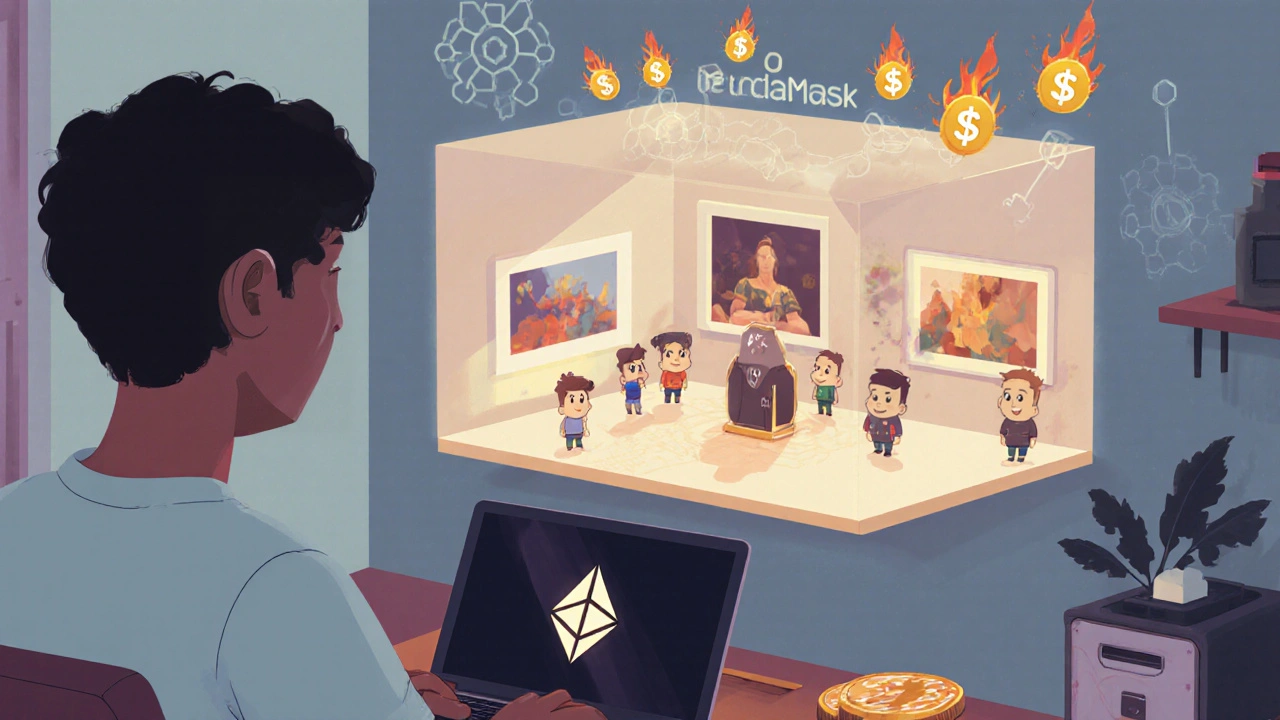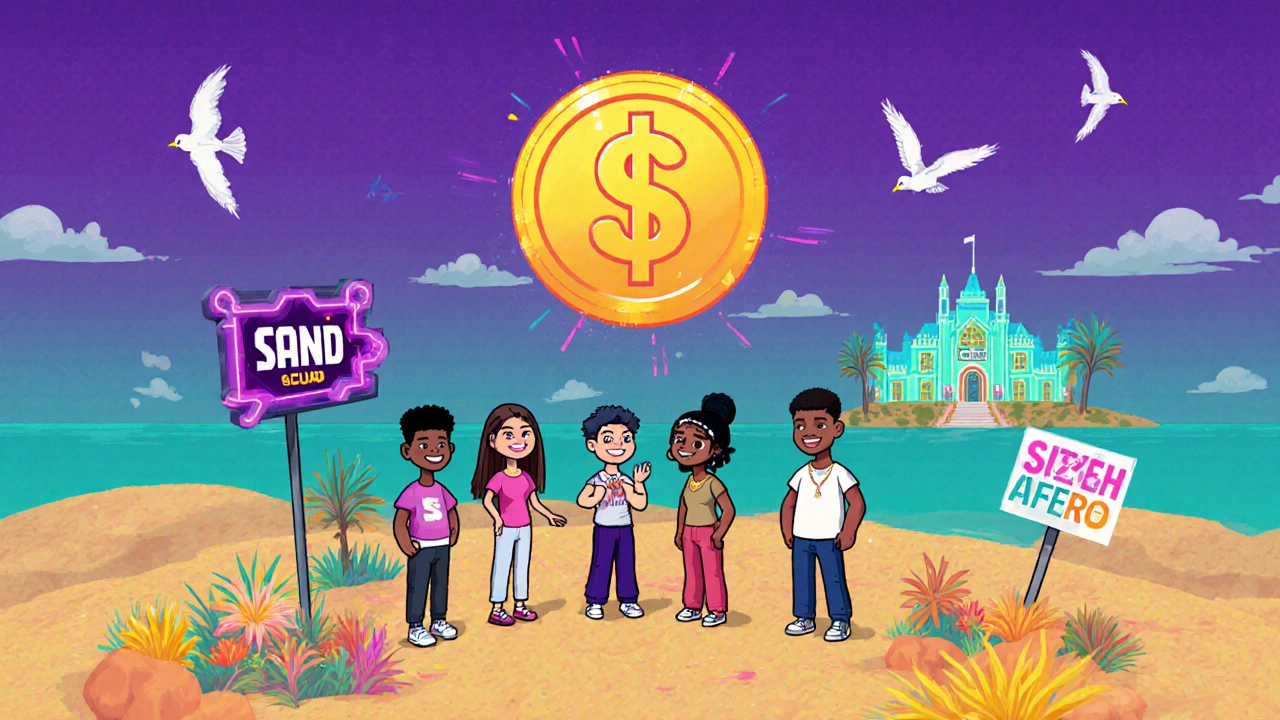Virtual Real Estate NFTs: Buying Land in the Metaverse
Imagine owning a piece of land that doesn’t exist in the physical world-no soil, no sky, no address. Yet, it’s yours. You can build on it, rent it out, sell it, or throw a party there. This isn’t science fiction. It’s happening right now in the metaverse, and people are spending real money to buy it. Virtual real estate NFTs are digital parcels of land in platforms like Decentraland, The Sandbox, and Somnium Space, each represented by a unique token on the blockchain. Unlike traditional property, you don’t get a deed from a county office-you get a digital certificate that proves you own it, forever, and no one can take it away unless they steal your private key.
What Exactly Are You Buying?
You’re not buying pixels. You’re buying ownership rights. Each plot of land in these virtual worlds is an NFT, meaning it’s one-of-a-kind, verifiable, and transferable. In The Sandbox, there are 166,464 total LAND parcels. Of those, 123,840 are available for purchase. In Decentraland, there are about 90,601 parcels, each measuring 16 meters by 16 meters in the virtual world. In Somnium Space, land is divided into just 5,026 uneven parcels, making scarcity even more pronounced.
These plots aren’t just empty lots. They’re canvases. You can turn them into a gallery, a nightclub, a store, a game, or even a virtual office. Some owners host live concerts. Others rent out spaces to brands for product launches. A plot near Snoop Dogg’s virtual mansion in The Sandbox sold for $450,000 in 2022-not because of the land itself, but because of the buzz around it. Location matters, just like in the real world.
How Does Ownership Work?
Every transaction is recorded on a blockchain-usually Ethereum. When you buy land, the NFT is sent to your crypto wallet. You control it with a private key. If you lose that key, you lose the land. No recovery. No customer service. No second chances. That’s the trade-off for true ownership.
Platforms like The Sandbox use $SAND tokens for transactions, while Somnium Space uses $CUBE. Decentraland uses $MANA. You need to buy one of these tokens, store it in a wallet like MetaMask, and then browse available plots on the platform’s marketplace or third-party sites like OpenSea. Once you find a plot, you click buy, confirm the transaction, and within seconds, the NFT lands in your wallet.
Transactions usually take 15-30 seconds. But during peak times, Ethereum gets congested. Fees can spike. You might pay $50 in gas just to buy a $5,000 plot. That’s why some platforms are moving to cheaper chains. Somnium Space switched to Polygon in August 2023, cutting fees by 37% and boosting sales.
Which Platform Should You Choose?
Not all metaverses are the same. Each has its own vibe, audience, and strengths.
- The Sandbox is the most active. It has the biggest user base, the most land transactions, and partnerships with big names like Snoop Dogg, Atari, and Adidas. Its voxel-based graphics make building fun and accessible, even for beginners. Average LAND price in Q3 2023: $6,200.
- Decentraland feels more like a real city. Its 3D environment is polished, and it’s the go-to for corporate events. Brands like Samsung and HSBC have set up virtual booths here. It’s also governed by a DAO, meaning token holders vote on platform changes. Average LAND price: $9,800.
- Somnium Space is built for VR. If you have an Oculus headset, this is the only platform where stepping into your land feels truly immersive. It’s smaller, less crowded, but more intimate. Average LAND price: $4,500.
There’s no “best” platform. It depends on what you want to do. Want to build games and attract young players? The Sandbox. Want to host a brand launch? Decentraland. Want to feel like you’re really standing on your property? Somnium Space.

Is It an Investment or a Gamble?
People bought virtual land in 2021 like it was gold. Prices soared. A plot in Decentraland sold for $2.4 million. But by 2023, the market cooled. Over 38% of listed LAND parcels on OpenSea sat unsold for more than six months. Many buyers didn’t build anything. They just hoped to flip. That’s speculation, not investment.
Dr. Jane Smith from MIT says NFTs solve digital scarcity-that’s real. But Professor Michael Chen from Stanford warns that over 80% of current sales show no utility. They’re just hype. The market hit $500 million in sales in 2022. Projections said it could hit $1 billion by late 2023. It didn’t. Growth stalled.
Still, real businesses are buying. PwC found that 30% of Fortune 500 companies now own virtual land. Why? For marketing. For customer engagement. For testing new ideas without risk. These aren’t speculators. They’re using the metaverse as a tool.
If you’re thinking of buying, ask yourself: Are you buying because you believe in the future of digital spaces? Or because you think someone else will pay more next month? The first can work. The second often ends in loss.
What Do You Need to Get Started?
Here’s the bare minimum:
- A crypto wallet (MetaMask is the most common)
- Funds in the right cryptocurrency ($SAND, $MANA, or $CUBE)
- A computer with a modern browser
- Patience. The learning curve is steep.
First-time buyers typically spend 8-12 hours just to complete their first purchase. Then comes the real work: learning how to build. The Sandbox offers VoxEdit and Game Maker-tools that let you design 3D objects and games without coding. Decentraland’s SDK is more complex. Somnium Space requires you to learn Unity if you want to go beyond basic builds.
You don’t need a VR headset to buy land. But if you want to experience it properly, you do. An Oculus Quest 2 costs around $300. That’s more than some plots. But for many, it’s worth it. One Steam reviewer put it best: “In VR, my land feels real. On a screen, it’s just a picture.”

Risks You Can’t Ignore
There are no guarantees here.
- Wallet theft: If your private key is leaked, your land is gone. No one can help you.
- Platform failure: What if The Sandbox shuts down? Your NFT still exists, but the world it lives in doesn’t. Your land becomes a digital artifact.
- Regulation: The U.S. SEC hasn’t ruled definitively, but they’ve hinted that some NFT land sales could be classified as securities. That could mean legal trouble.
- Interoperability: Your land in Decentraland won’t work in The Sandbox. You’re locked in.
And then there’s the biggest risk: no one shows up. You build a virtual nightclub. You spend $20,000. You host a party. Three people show up. That’s happened. More than once.
Who’s Winning Right Now?
Not the speculators. The builders are winning.
One Reddit user bought a plot in The Sandbox for 4 ETH ($5,200 in 2022). Instead of flipping it, he turned it into a virtual event space for small businesses. He charges $200 per hour to rent it out. In 10 months, he recouped 60% of his investment. He didn’t need to sell. He just needed to use it.
Another owner in Decentraland turned a small plot into a digital art gallery. She partnered with five indie artists. Each month, she hosts a new exhibit. She sells prints and NFTs of the art. She makes more from commissions than she ever could from selling the land.
Success isn’t about buying cheap and selling high. It’s about creating value. The land is just the foundation.
What’s Next?
The metaverse isn’t dead. It’s evolving. Apple’s Vision Pro headset launched in December 2023, and early adopters are already exploring Somnium Space and Decentraland in VR. Gartner predicts that by 2026, 25% of people will spend at least one hour a day in the metaverse-for work, shopping, or socializing. That’s a huge shift.
Platforms are working on interoperability. The Metaverse Standards Forum includes over 1,800 companies trying to make assets transferable between worlds. If that happens, your land could become more valuable, not less.
AI tools are also lowering the barrier to entry. Soon, you might be able to type “build a neon-lit cyberpunk bar” and have an AI generate it for you. That could unlock a wave of new creators.
Virtual real estate NFTs are still early. They’re messy. They’re risky. But they’re also real. The technology behind them-blockchain, digital ownership, decentralized control-is here to stay. Whether virtual land becomes a mainstream asset or fades into a niche curiosity depends on one thing: utility. The more people use these spaces, the more they’ll be worth.
Don’t buy land because you think it’ll double in price. Buy it because you want to build something no one else can. That’s the only way to win.
Can you really make money from virtual real estate NFTs?
Yes, but not by just buying and holding. People make money by building experiences-like virtual stores, galleries, or event spaces-and charging for access or selling digital goods. Some earn through rentals, others through commissions on art or NFT sales. Flipping land for profit rarely works anymore. Success comes from creating value, not speculation.
How much does virtual land cost today?
Prices vary by platform and location. As of late 2023, average prices are around $4,500 in Somnium Space, $6,200 in The Sandbox, and $9,800 in Decentraland. Premium plots near popular landmarks or celebrity-owned areas can cost $50,000 or more. Entry-level plots can be found for under $2,000, but they’re often harder to develop or rent out.
Do you need VR to buy or use virtual land?
No, you don’t need VR to buy land. You can browse, purchase, and even build on most platforms using a regular computer and browser. But if you want to truly experience your property-walk around it, interact with visitors, feel like you’re inside it-you’ll need a VR headset like the Oculus Quest 2 or Apple Vision Pro. The experience is vastly better in VR.
What’s the biggest risk of buying virtual land?
The biggest risk is losing access to your private key. If you misplace it or get hacked, your land is gone forever. There’s no password reset. No customer support. No recovery. Beyond that, the biggest risk is building something no one uses. Many plots sit empty because owners didn’t plan for real engagement.
Can you sell virtual land anytime?
Yes, you can list your land for sale anytime on marketplaces like OpenSea or the platform’s own marketplace. But finding a buyer isn’t guaranteed. As of Q3 2023, over 38% of listed LAND parcels remained unsold for more than six months. Market conditions, platform popularity, and plot location all affect how quickly you can sell.
Is virtual real estate legal?
There’s no global law against owning virtual land. But regulators are watching. The U.S. SEC has indicated that some NFT land sales could be classified as securities if they promise returns or profits to buyers. That could trigger legal requirements. Always check your local regulations before investing.
What’s the difference between The Sandbox and Decentraland?
The Sandbox is more playful and game-focused, with voxel-style graphics and easy-to-use tools for creators. It’s popular with gamers and brands wanting interactive experiences. Decentraland is more realistic and polished, with a stronger focus on social spaces, corporate events, and community governance through its DAO. It’s the preferred choice for professional use. The Sandbox has more land and higher transaction volume; Decentraland has higher average land prices and more enterprise adoption.
Are there any free ways to try virtual real estate?
Yes. Most platforms offer free demo versions or limited-access plots. The Sandbox has a free creator mode where you can build without owning land. Decentraland lets you explore the world without buying anything. Somnium Space offers a free web version. These let you test the interface, learn the tools, and see if you enjoy the experience before spending money.





